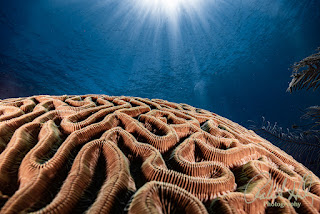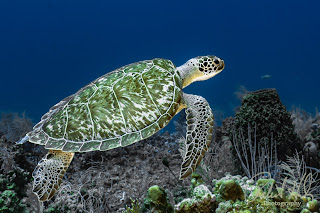Underwater Water Color Correction: Fixing Green and Murky Hues in Lightroom
Underwater Water Color
Correction: Fixing Green and Murky Hues in Lightroom
Green. Murky. Milky.
We’ve all been there.
Even when utilizing the highest-quality strobes and the most meticulously adjusted white balance settings, there are still certain dives where the water's color can transform your underwater photos into images that resemble something out of a murky swamp rather than capturing the vibrant and lively essence of a colorful coral reef. This phenomenon can occur for various reasons, including algae blooms that cloud the water, poor visibility due to sediment or particles, or the effects of deep ambient light filtering through the surface. However, the good news is that with the powerful editing capabilities of Lightroom, it’s possible to correct those unnatural water hues. By applying the proper adjustments, a shot that might initially seem unusable can be transformed into a breathtaking piece of art worthy of display on your wall. This process enhances the visual appeal of the photograph and brings out the true beauty of the underwater world you experienced during your dive.
In this week’s blog, I’ll walk you through step-by-step
Lightroom Classic adjustments to help you correct green or milky water
backgrounds and restore your photos to showcase the true beauty of the
underwater world.
Why Water Goes Green (or Worse)
Before we dive into edits, it’s helpful to understand why
these shifts occur. Green water usually stems from:
- High
levels of plankton or algae (common in temperate waters)
- Shallow
coastal bays or lagoons
- Backscatter
magnifying ambient hues
- White
balance issues or incorrect camera settings
- Overexposure
in RAW files
Fortunately, Lightroom Classic has all the tools we need to
fix this. Let’s explore them.
✅ Step-by-Step Corrections in
Lightroom
1. Use the AI Masking Tool: Select Background
Best For: Shots where your subject is clear but the
water is murky or discolored.
Steps:
- Hit M
to open the Masking Panel.
- Click “Select
Background” (Lightroom’s AI will isolate the water from your subject).
- Reduce
Green Tint using the Temp/Tint sliders (push Tint toward
magenta).
- Decrease
Saturation to neutralize the background.
- Increase
Dehaze (+10 to +25) and reduce Exposure if water is overly
bright.
Shortcut:
Shift + W opens the Masking Tool.
Use Cmd + Option + H (Mac) or Ctrl + Alt + H (PC) to toggle mask visibility.
2. Adjust White Balance Globally for Mild Green Casts
Best For: The entire image is evenly tinted green.
Steps:
- In the
Basic Panel, adjust:
- Temp: Increase (move the slider to the right) to warm the image slightly.
- Tint:
Increase (toward Magenta) to correct the greenish cast.
- Compare with the original using the \ (Backslash) key.
Tip: Don’t go too far—overcorrecting can make the
water look purple or brown.
3. Apply Color Grading to the Midtones or Shadows
Best For: Murky water with a color shift, mainly in
darker areas.
Steps:
- Go to the Color
Grading Panel.
- Select
Shadows or Midtones.
- Gently
shift the hue toward Blue-Aqua or Magenta, depending on the image's needs.
- Reduce
Luminance slightly to help obscure background haze.
Shortcut:
Cmd + 3 (Mac) or Ctrl + 3 (PC) to jump to the Color Grading Panel.
4. Tone Curve Adjustments to Remove Milky Water Look
Best For: Dull, hazy water with low contrast.
Steps:
- Go to
the Tone Curve.
- Add a
control point in the Shadows and pull down slightly.
- Add
another in the Highlights and pull up.
- This
increases contrast, reducing haze and “fog.”
Pro Tip: You can create a slight “S-Curve” for that
extra punch.
5. Use the HSL Panel to Desaturate Greens and Yellows
Best For: Shallow green water where the algae creates
unnatural color.
Steps:
- Go to the HSL/Color
Panel.
- Select
Saturation.
- Reduce
Green, Yellow, and Aqua sliders as needed.
- In Luminance,
raise Aqua and Blue slightly to brighten clean water tones.
Shortcut:
Click the Targeted Adjustment Tool in HSL (Alt + Click on PC or Option +
Click on Mac) to drag on water areas directly.
6. AI “Select Sky” Hack for Top-of-Frame Water
Best For: Split-shots or upward angles with green
water at the top.
Steps:
- Hit M
for Masking.
- Choose
Select Sky – Lightroom sees the surface water as “sky.”
- Desaturate
and shift the Tint toward magenta or blue.
- Lower
Exposure and apply Clarity or Texture if needed.
7. Radial Filter for Local Water Corrections
Best For: Correcting green hues around the subject or
strobes.
Steps:
- Press Shift
+ M to activate the Radial Gradient tool.
- Draw around the subject and invert the mask.
- Lower Saturation,
increase Dehaze and adjust Tint to magenta.
Bonus: Add a second radial around the diver or marine
life to bring out natural color (boost Contrast, Texture, and Warmth).
8. Use “Point Color” (New in Lightroom Classic)
Best For: Precision color corrections when green is
isolated to specific tones.
Steps:
- Scroll
to the Point Color panel.
- Use
the Eyedropper to sample the exact green hue.
- Adjust
Hue, Saturation, and Luminance sliders for only that
color.
Tip: This is perfect for removing leftover green
water while preserving blue tones.
9. Apply AI Adaptive Presets (Optional for Speed)
Best For: Batch editing green or hazy dive photos.
Steps:
- Apply Adobe’s “Whiten Teeth” preset using the Background Mask to the water. (Yes, it reduces green hues.)
- Or
create your own “Clean Blue Water” preset using the settings from
above.
10. Final Touch: Use Lens Corrections + Profile
Best For: Removing haze caused by dome ports and soft
corners.
Steps:
- Go to
Lens Corrections Panel.
- Check
Remove Chromatic Aberration and Enable Profile Corrections.
- If
your lens isn’t recognized, manually select your camera and lens combo.
Wrap-Up: Turning Murky into Magic
Underwater photography offers a unique opportunity to capture breathtaking moments hidden from the surface, revealing a vibrant world full of life and color beneath the waves. However, one of the significant challenges photographers face in this environment is the often poor underwater water color, which can distort the images and diminish their overall quality, even when the shot's composition is perfect. This issue arises because water can significantly filter specific wavelengths of light, leading to a lack of natural colors that can make underwater scenes look dull or murky.
Fortunately, Adobe Lightroom Classic provides powerful editing tools explicitly designed to address these challenges. With its latest advancements in AI masking and enhanced color grading capabilities, photographers can effectively restore and enhance the original beauty of their underwater images. These features allow for precise adjustments and refinements, enabling one to bring out the vivid colors and intricate details that genuinely represent the underwater experience. By utilizing these tools, underwater photographers can transform their images, making them more lifelike and visually engaging for viewers.
Remember, no one tool fits every image. Try combining
several of these steps for the most natural results. Create a few
custom presets based on your favorite edits to streamline your workflow for
green water days.
Next time you surface from a murky dive and think your shots
are a lost cause - don’t delete them. Open up Lightroom, follow these tips, and
give them a second chance. You might be surprised at how much magic still hides behind that haze.
🎯 Tip of the Week:
“Use the ‘Select Background’ mask first—it often gets the water right on
the first try. Combine it with Point Color for precise cleanup.”
Do you have questions or want to share your own before-and-after results? Send me a message or comment below.
I’d love to see how your photos improve!
Until next time, keep shooting blue.
- Robert
- 💡 Read more Lightroom tips at RobertHerb.blogspot.com.
- 💡 Join my upcoming online training program – Learn to enhance your underwater shots with Adobe Lightroom! Sign up for a FREE "Before & After" Gallery.
- 💡 Share your processed photos on social media using #RobertHerbPhotography.
- 💡 Have questions? Email me at bob@robertherb.com.
Written by Robert Herb – Empowering underwater photographers to capture and enhance the beauty of our oceans.
Stay tuned for more in-depth insights into underwater photography. Let’s dive deeper into the art and craft of capturing the marine world! If you have any comments or suggestions, I’d love to hear them.
Get ready for an exciting underwater photography adventure! For more details on my upcoming online training course, check out my "Training" page at RobertHerb.com or email me at bob@robertherb.com.
Sincerely,
Bob Herb
|
|





Comments
Post a Comment
Please let me know your comments.